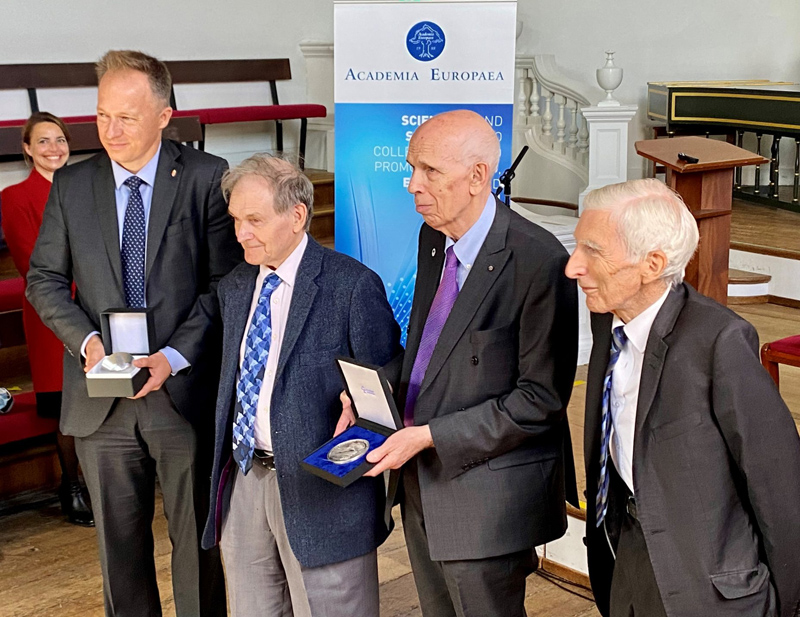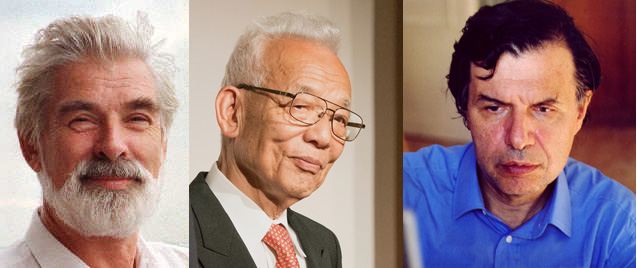Special interview with Sir Roger Penrose, Nobel laureate and this year’s winner of Academia Europaea’s Erasmus Medal#
Professor Roger Penrose delivered the Heinz-Nixdorf Erasmus lecture which was streamed at the 32nd Annual conference of AE members in Barcelona. #
For the 20th in the Interview Spotlight series of the Academia Europaea Cardiff Knowledge Hub , the Hub was honoured to meet with world-renowned mathematician, physicist and Nobel laureate, Professor Sir Roger Penrose OM FRS MAE, winner of Academia Europaea’s Erasmus Medal, 2021.
, the Hub was honoured to meet with world-renowned mathematician, physicist and Nobel laureate, Professor Sir Roger Penrose OM FRS MAE, winner of Academia Europaea’s Erasmus Medal, 2021.
This interview took place following a very special award ceremony for Sir Roger at Wadham College , University of Oxford, on 24th September, at which Sir Roger was presented with the Erasmus Medal and gave the accompanying Erasmus Lecture. Professor Ole Petersen CBE FMedSci FLSW MAE ML FRS, Vice-President of the Academia Europaea, presented the medal on behalf of the AE President. The lecture was streamed during the opening session of the Annual Meeting of the Academia on 20th October, 2021. The laudation was given by Astronomer Royal Professor Martin Rees, The Lord Rees of Ludlow, OM, FRS, FREng, FMedSci, FBA (Hon) MAE.
, University of Oxford, on 24th September, at which Sir Roger was presented with the Erasmus Medal and gave the accompanying Erasmus Lecture. Professor Ole Petersen CBE FMedSci FLSW MAE ML FRS, Vice-President of the Academia Europaea, presented the medal on behalf of the AE President. The lecture was streamed during the opening session of the Annual Meeting of the Academia on 20th October, 2021. The laudation was given by Astronomer Royal Professor Martin Rees, The Lord Rees of Ludlow, OM, FRS, FREng, FMedSci, FBA (Hon) MAE.
Sir Roger, many congratulations on being awarded Academia Europaea’s Erasmus Medal. Over a long and successful career, with many significant contributions to science, what are the moments that stand out to you most? Who would you say were the people who had the greatest impact on your work and career?
We also explored geometry. We were in Canada during the war years, and I’d noticed a pattern of regular hexagons on a tiled sink. I asked my father if it would be possible for the whole world to be covered by these hexagons. He replied that it wasn’t, but it could be done with pentagons, by which he meant a regular dodecahedron. This was part of my geometrical education as I grew up!
I also learnt a lot from my older brother, who was precocious and 2 years ahead of his class. I was always extremely slow. In fact, in my first year in Canada, my teacher moved me down to a lower grade class. She used to issue mental arithmetic tests, which were too quick for me. A year or two later, another teacher realised that I was just slow, not actually stupid, so gave me as much time as I needed for maths tests. I’d watch people playing outside through the window, whilst I was still struggling through my test! I remained slow but managed to speed up for my later exams. Back in England, as a third-year undergraduate in Mathematics at University College, I specialised in two geometrical subjects. I could see how to do the geometrical problems, but explaining them in words made me slow and I didn’t complete all the papers. In fact, my best paper was in algebra, which didn’t require the same sort of approach.”
It was topology, (the mathematics that describes the properties of geometric objects as they are twisted or stretched) that helped you solve the problem of black holes. What was it that drew you to this area of mathematics?
 at Princeton, who was very interested in fundamental physics, general relativity in particular, and the question of the singularities. People thought they shouldn’t be there in general, and I think that’s what Einstein would have thought too. I never met Einstein. However, my close friend and colleague, the British physicist Dennis Sciama
at Princeton, who was very interested in fundamental physics, general relativity in particular, and the question of the singularities. People thought they shouldn’t be there in general, and I think that’s what Einstein would have thought too. I never met Einstein. However, my close friend and colleague, the British physicist Dennis Sciama did. Dennis was a great influence on me and kept trying to convert me to cosmology.
did. Dennis was a great influence on me and kept trying to convert me to cosmology.
Wheeler was really interested in what happened in gravitational collapse. The term ‘black hole’ apparently came from Wheeler, although it was in fairly common usage at the time. The question of the singularities was not clear, particularly because there was a paper written by two Russians, Liftshitz and Khalatnikov (1963), who seemed to have proved that in a general situation you would not get singularities and a black hole would not form. I became intrigued by the problem because of the quasar interest; it was topical. I looked at the Liftshitz and Khalatnikov paper and was not convinced by the techniques they were using. There was a serious error in the paper, which I didn’t notice, but was later corrected after I’d published my result. I’d developed a technique of squashing infinity down, until it became a finite place, just like anywhere else. I wrote a paper for the Royal Society (Penrose, 1965), where, as an afterthought, I realised that to prove this one thing, I had to assume that infinity was like a sphere. The family of spatial directions at point in space forms a sphere, but when you get to infinity, does this family still stay a sphere, or could it have some more complicated topology? I wrote an appendix to the paper, where I had a proof that it had to be a sphere. Looking at the boundaries of futures, you have a point or a region in space-time and you look at what this can reach. What does the boundary of it look like? This was a very crucial part of the argument I used for the appendix in this paper. I began to think that maybe this technique could be used for black holes but I had no way of characterising what a black hole was in general. I remember walking with a friend, Ivor Robinson
 , near Birkbeck College in London. I had this sudden feeling of elation crossing a street, and it was the idea that I subsequently referred to as a ‘trapped surface’. This was a characterisation of a gravitational collapse that had gone too far and that the boundary of its future had to be compact, which is contradictory to the initial non-compact state. I went back to my office at Birkbeck and sketched out an argument for it. I got a curious reaction from people. People didn’t take it that I was showing that black holes were there; there was real suspicion and it took a while before they were accepted.”
, near Birkbeck College in London. I had this sudden feeling of elation crossing a street, and it was the idea that I subsequently referred to as a ‘trapped surface’. This was a characterisation of a gravitational collapse that had gone too far and that the boundary of its future had to be compact, which is contradictory to the initial non-compact state. I went back to my office at Birkbeck and sketched out an argument for it. I got a curious reaction from people. People didn’t take it that I was showing that black holes were there; there was real suspicion and it took a while before they were accepted.”
You said that black holes have become increasingly important in our understanding of the Universe. What do you think are the next important areas of research and discovery, that could have a profound impact on the way we look at the Universe?
For a long time, I believed that the resolution of this issue lay in a phenomenon known as the ‘collapse of wave function’. This has to do with what is called the ‘measurement problem’ of quantum mechanics. Is it the conscious observer looking at the state that makes it collapse? I couldn’t make sense of that, so I looked at it the other way round. It’s gravity that makes it collapse. There are good reasons for believing that the general principles of relativity and quantum mechanics are incompatible. I think that’s because gravity is influencing quantum mechanics and the collapse is a gravitational effect. It’s not due to consciousness. We do not know what the physics is, and how the collapse of the wave function takes place. There are new experiments which should be done, but need money.”
Do you have any unfulfilled ambitions?
 and mathematics.”
and mathematics.”
About Professor Sir Roger Penrose OM FRS MAE#
Sir Roger Penrose OM FRS MAE is a mathematician, mathematical physicist, philosopher of science and Wadham Emeritus Fellow at the University of Oxford . Sir Roger is famous globally for his many contributions to the mathematical physics of general relativity and cosmology. He has received a great number of highly prestigious awards including the 1988 Wolf Prize in Physics, which he shared with Stephen Hawking
. Sir Roger is famous globally for his many contributions to the mathematical physics of general relativity and cosmology. He has received a great number of highly prestigious awards including the 1988 Wolf Prize in Physics, which he shared with Stephen Hawking , and the Royal Society’s 2008 Copley Medal
, and the Royal Society’s 2008 Copley Medal . In October 2020, Sir Roger was awarded one half of the Nobel Prize in Physics
. In October 2020, Sir Roger was awarded one half of the Nobel Prize in Physics “for the discovery that black hole formation is a robust prediction of the general theory of relativity”. Sir Roger celebrated his 90th birthday earlier this year.
“for the discovery that black hole formation is a robust prediction of the general theory of relativity”. Sir Roger celebrated his 90th birthday earlier this year.
About the Erasmus Medal#
Academia Europaea’s Erasmus Medal is awarded to a scholar who has maintained, over a sustained period, the highest level of international scholarship. The medallist is invited to give the annual Erasmus Lecture during the opening session of the Annual Meeting of the Academia. The Medal and Lecture are currently sponsored by The Heinz-Nixdorf Foundation.
References#
Lifshitz, E.M. and Khalatnikov, I.M. (1963). Investigations in relativistic cosmology, in Advances in Physics 12,185-249 .
Penrose, R. (1965). Zero rest-mass fields including gravitation: asymptotic behaviour, Proc. Roy. Soc. London, A284, 159-203 .
You may also be interested in this item
2021 Nobel Prize in Physics awarded to three members of Academia Europaea#
Our congratulations to Professor Syukuro Manabe MAE, Professor Klaus Hasselmann MAE, and Professor Giorgio Parisi MAE, who are among this year’s Nobel Prize winners. Read the announcement.



